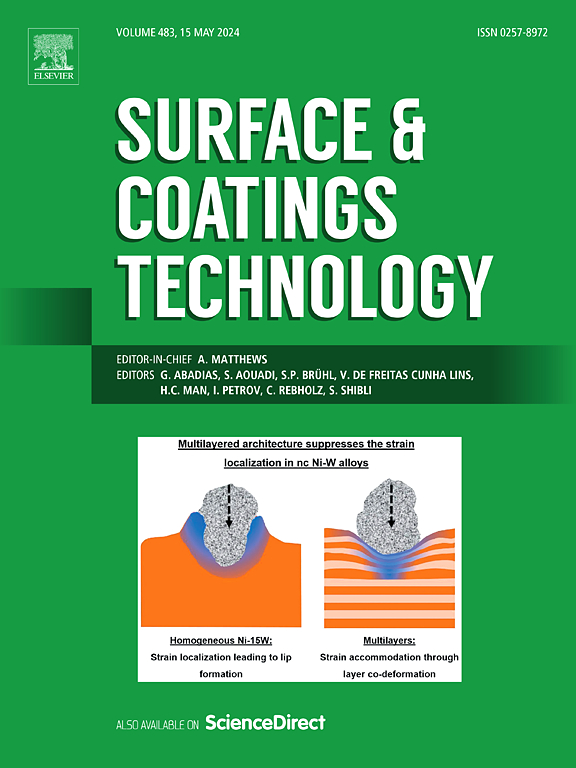Post-processing of laser-directed energy deposited IN718 superalloys through combined heat treatment and shot peening: Microstructural evolution and wear resistance enhancement
IF 5.3
2区 材料科学
Q1 MATERIALS SCIENCE, COATINGS & FILMS
引用次数: 0
Abstract
While the laser-directed energy deposition (LDED) technique is extensively employed for repairing and fabricating complex components, LDED-fabricated IN718 superalloys parts frequently exhibit inadequate wear resistance. This study systematically investigates the combination effects of heat treatment strategies (i.e., direct double aging (DA) and solution + double aging (SDA) treatments) and shot peening (SP) on the microstructural evolution and 600 °C wear performance of LDED-fabricated IN718 alloys. The aging regime promotes the complete precipitation of γ″/γ′ phases, while the prior solution treatment in the SDA process achieves concurrent dissolution of most Laves phases and partial recrystallization. SP converts surface tensile stress into compressive stress, reaching –1030.67 MPa in SDA + SP. Additionally, SP induces a work-hardened layer with a depth of ∼ 250 μm and a ∼ 500 nm thick nanograin layer at the topmost surface. The grain nanocrystallization is attributed to the simultaneous action of dislocations, twins, stacking faults, and Lomer-Cottrell (L-C) locks. The synergistic effects of grain refinement, work hardening, and γ″/γ′ precipitation collectively endow the SDA + SP sample with optimal sliding wear performance at 600 °C, exhibiting a 14.8 % reduction in average coefficient of friction and a remarkable 78.9 % decrease in wear rate compared to the as-received sample. This performance enhancement correlates with a transition in wear mechanisms to predominantly abrasive and oxidation-dominated regimes under elevated temperature conditions.
激光定向能沉积IN718高温合金复合热处理和喷丸强化后处理:显微组织演变和耐磨性增强
虽然激光定向能量沉积(LDED)技术被广泛用于修复和制造复杂的部件,但led制造的IN718高温合金部件经常表现出不足的耐磨性。本研究系统地研究了热处理策略(即直接双时效(DA)和固溶+双时效(SDA)处理)和喷丸强化(SP)对led制造IN718合金组织演变和600°C磨损性能的综合影响。时效处理促进了γ″/γ′相的完全析出,而在SDA工艺中预先固溶处理实现了大部分Laves相的同时溶解和部分再结晶。SP将表面拉应力转化为压应力,在SDA + SP中达到-1030.67 MPa。此外,SP在最表层形成深度为~ 250 μm、厚度为~ 500 nm的加工硬化层。晶粒的纳米化是位错、孪晶、层错和lomo - cottrell (L-C)锁共同作用的结果。晶粒细化、加工硬化和γ″/γ′析出的协同作用共同赋予了SDA + SP试样在600℃时的最佳滑动磨损性能,与接收样品相比,平均摩擦系数降低了14.8%,磨损率显著降低了78.9%。在高温条件下,这种性能的增强与磨损机制的转变有关,磨损机制以磨料和氧化为主。
本文章由计算机程序翻译,如有差异,请以英文原文为准。
求助全文
约1分钟内获得全文
求助全文
来源期刊

Surface & Coatings Technology
工程技术-材料科学:膜
CiteScore
10.00
自引率
11.10%
发文量
921
审稿时长
19 days
期刊介绍:
Surface and Coatings Technology is an international archival journal publishing scientific papers on significant developments in surface and interface engineering to modify and improve the surface properties of materials for protection in demanding contact conditions or aggressive environments, or for enhanced functional performance. Contributions range from original scientific articles concerned with fundamental and applied aspects of research or direct applications of metallic, inorganic, organic and composite coatings, to invited reviews of current technology in specific areas. Papers submitted to this journal are expected to be in line with the following aspects in processes, and properties/performance:
A. Processes: Physical and chemical vapour deposition techniques, thermal and plasma spraying, surface modification by directed energy techniques such as ion, electron and laser beams, thermo-chemical treatment, wet chemical and electrochemical processes such as plating, sol-gel coating, anodization, plasma electrolytic oxidation, etc., but excluding painting.
B. Properties/performance: friction performance, wear resistance (e.g., abrasion, erosion, fretting, etc), corrosion and oxidation resistance, thermal protection, diffusion resistance, hydrophilicity/hydrophobicity, and properties relevant to smart materials behaviour and enhanced multifunctional performance for environmental, energy and medical applications, but excluding device aspects.
 求助内容:
求助内容: 应助结果提醒方式:
应助结果提醒方式:


